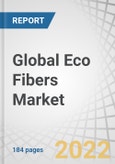The global eco fibers market is estimated to be worth USD 52 billion in 2022 and is projected to reach USD 78.3 billion by 2027, rising at a CAGR of 8.5%. The rising customer demand for environmentally friendly products that support sustainability is predicted to drive the eco-fibers market growth in the forecasted period. Eco fibers possess several properties include high wet tenacity, good absorbency, softness, lustre, ease of dyeing, and biodegradability, that will increases their demand in several applications such as clothing/fabrics, household furnishings, industrial, medical, and others.
By Type, the Regenerated Fibers segment accounted for the highest CAGR during the forecast period
Due to rising customer demand for environmentally friendly products that support sustainability, regenerated fibers are predicted to expand at the quickest rate during the anticipated period. High wet tenacity, good absorbency, softness, lustre, ease of dyeing, biodegradability, and nice drape are just a few of the excellent features that make regenerated cellulosic fiber a viable replacement for synthetic fibers. Viscose and lyocell are the two major regenerated fibers that have been considered, as they are the most used fibers in this category. Viscose is a cellulosic fiber derived from wood pulp through the viscose process.
By Application, Industrial accounted for the highest CAGR during the forecast period
Eco fibers are utilised in industrial applications including labels, labels, ropes, shoes, automobile parts, solar panels, and apparel that is resistant to flames. The main eco fibers used in industrial applications are lyocell, recovered polyester, viscose, and organic cotton recycle. Due to the increased use of eco fibers in a variety of flame-retardant protective clothing that is further used in civilian and military applications such as fire-resistant suits, gloves, and other items, the Industrial application is the end-use industry segment for organic cotton fibers that is growing at the fastest rate.
APAC is projected to account for the highest CAGR in the eco fibers market during the forecast period
The APAC region is predicted to experience the fastest market growth for eco fibers during the forecast period. China, Japan, India, Indonesia, and the rest of APAC make up the majority of the market for eco fibers in APAC, which is also where they are consumed the fastest. In 2021, this region is anticipated to have the highest market for eco fibers The market in the APAC region is likely to be driven by a healthy expansion of the manufacturing sector, rising FDI investment in the region, relocation of manufacturing operations to India, China, and ASEAN nations, tightening regulatory requirements, and rising investment in fabric, automotive, and other applications in the region.
Eco fibers are highly used in the textile and apparel industry to provide better finish and durability to the variety of fabrics. Therefore, the Textile and Apparel Industry dominates the demand for eco fibers in APAC region.
Research Coverage
The market study covers the Eco fibers market across various segments. It aims at estimating the market size and the growth potential of this market across different segments based on Source, manufacturing process, application, type, and region. The study also includes an in-depth competitive analysis of key players in the market, their company profiles, key observations related to their products and business offerings, recent developments undertaken by them, and key growth strategies adopted by them to improve their position Eco fibers market.
The Eco Fibers market consists of major manufacturers such as Sateri (China), Lenzing AG (Austria), Grasim Industries Limited (India), Polyfiber LTD (India), and Us Fibers (US) are the key players operating in the Eco fibers market. Expansions, acquisitions, joint ventures, and new product developments are some of the major strategies selected by these key players to boost their positions in the Eco Fiber market.
Breakup of Primaries
- By Company Type: Tier 1: 20%, Tier 2: 60%, and Tier 3: 20%
- By Designation: C-level Executives: 45%, Directors: 25%, and Others: 30%
- By Region: North America: 25%, Europe: 30%, Asia-Pacific: 35%, Middle East & Africa: 5%, and South America: 5%
Key Benefits of Buying the Report
The report is expected to help the market leaders/new entrants in this market share the closest approximations of the revenue numbers of the overall Eco fibers market and its segments and sub-segments. This report is projected to help stakeholders understand the competitive landscape of the market, gain insights to improve the position of their businesses and plan suitable go-to-market strategies. The report also aims at helping stakeholders understand the pulse of the market and provides them with information on the key market drivers, challenges, and opportunities.
Table of Contents
Companies Mentioned
- China Bambro Textile (Group) Co. Ltd.
- David C. Poole Company, Inc.
- Foss Manufacturing Company, LLC.
- Grasim Industries Limited
- Lenzing AG
- Oerlikon
- Pilipinas Ecofiber Corporation
- Polyfibre Industries Pvt. Ltd.
- Shanghai Tenbro Bamboo Textile Co. Ltd.
- Tangshan Sanyou Group Xingda Chemical Fibre Co. Ltd.
- Teijin Limited
- US Fibers
- Wellman Plastics Recycling, LLC
Methodology

LOADING...
Table Information
| Report Attribute | Details |
|---|---|
| No. of Pages | 184 |
| Published | October 2022 |
| Forecast Period | 2022 - 2027 |
| Estimated Market Value ( USD | $ 52 Billion |
| Forecasted Market Value ( USD | $ 78.3 Billion |
| Compound Annual Growth Rate | 8.5% |
| Regions Covered | Global |
| No. of Companies Mentioned | 13 |









